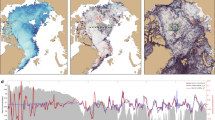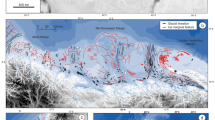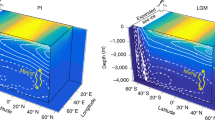Abstract
Palaeoclimate records have revealed the presence of millennial-scale climate oscillations throughout the last glacial period1. Six periods of extreme cooling in the Northern Hemisphere—known as Heinrich events—were marked by an enhanced discharge of icebergs into the North Atlantic Ocean2,3, increasing the deposition of ice-rafted debris2. Increased sliding at the base of ice sheets as a result of basal warming has been proposed to explain the iceberg pulses4,5,6, but recent observations7,8 suggest that iceberg discharge is related to a strong coupling between ice sheets, ice shelves and ocean conditions. Here we use a conceptual numerical model to simulate the effect of ocean temperature on ice-shelf width, as well as the impact of the resultant changes in ice-shelf geometry on ice-stream velocities. Our results demonstrate that ocean temperature oscillations affect the basal melting of the ice shelf and will generate periodic pulses of iceberg discharge in an ice sheet with a fringing shelf. We also find that the irregular occurrence of Heinrich events seen in the palaeoclimate records can be simulated by periodic ocean forcing combined with varying accumulation rates of the ice sheet. Our model simulations support a link between millennial-scale ocean temperature variability and Heinrich events during the last glacial period.
This is a preview of subscription content, access via your institution
Access options
Subscribe to this journal
Receive 12 print issues and online access
$259.00 per year
only $21.58 per issue
Buy this article
- Purchase on Springer Link
- Instant access to full article PDF
Prices may be subject to local taxes which are calculated during checkout



Similar content being viewed by others
References
Dansgaard, W. et al. Evidence for general instability of past climate from a 250-kyr ice-core record. Nature 364, 218–220 (1993).
Heinrich, H. Origin and consequences of cyclic ice rafting in the northeast Atlantic Ocean during the past 130,000 years. Quat. Res. 29, 142–152 (1988).
Grousset, F. et al. Zooming in on Heinrich layers. Paleoceanography 16, 240–259 (2001).
MacAyeal, D. R. Binge/purge oscillations of the Laurentide ice sheet as a cause of the North Atlantic’s Heinrich events. Paleoceanography 8, 775–784 (1993).
Calov, R., Ganopolski, A., Petoukhov, V., Claussen, M. & Greve, R. Large-scale instabilities of the Laurentide ice sheet simulated in a fully coupled climate-system model. Geophys. Res. Lett. 29, 2216–2219 (2002).
Papa, B., Mysak, L. & Wang, Z. Intermittent ice sheet discharge events in northeastern North America during the last glacial period. Clim. Dyn. 26, 201–216 (2006).
Rignot, E. et al. Accelerated ice discharge from the Antarctic Peninsula following the collapse of Larsen B ice shelf. Geophys. Res. Lett. 31, 18 (2004).
Flückiger, J., Knutti, R. & White, J. Oceanic processes as potential trigger and amplifying mechanisms for Heinrich events. Paleoceanography 21, PA2014 (2006).
Ganopolski, A. & Rahmstorf, S. Rapid changes of glacial climate in a coupled climate model. Nature 409, 153–158 (2001).
Braun, H. et al. Possible solar origin of the 1,470-year glacial climate cycle demonstrated in a coupled model. Nature 438, 208–211 (2005).
Broecker, W., Bond, G., Klas, M., Clark, E. & McManus, J. Origin of the northern Atlantic’s Heinrich events. Clim. Dyn. 6, 265–273 (1992).
Grousset, F. et al. Patterns of ice-rafted detritus in the glacial North Atlantic. Paleoceanography 8, 175–192 (1993).
De Vernal, A. et al. Comparing proxies for the reconstruction of LGM sea-surface conditions in the northern North Atlantic. Quat. Sci. Rev. 25, 2820–2834 (2006).
Bond, G. et al. Correlations between climate records from North Atlantic sediments and Greenland ice. Nature 365, 143–147 (1993).
Marshall, S. & Koutnik, M. Ice sheet action versus reaction: Distinguishing between Heinrich events and Dansgaard–Oeschger cycles in the North Atlantic. Paleoceanography 21, 1-A2021 (2006).
Calov, R. et al. First results of the ISMIP-HEINO Model Intercomparison Project. Geophys. Res. Abstr. 9, EGU2007-A-02910 (2007).
Hulbe, C., MacAyeal, D., Denton, G., Kleman, J. & Lowell, T. Catastrophic ice shelf breakup as the source of Heinrich event icebergs. Paleoceanography 19, PA1004 (2004).
Rasmussen, T. & Thomsen, E. The role of the North Atlantic drift in the millennial timescale glacial climate fluctuations. Palaeogeogr. Palaeoclimatol. Palaeoecol. 210, 101–116 (2004).
Dokken, T. & Jansen, E. Rapid changes in the mechanism of ocean convection during the last glacial period. Nature 401, 458–461 (1999).
Mignot, J., Ganopolski, A. & Levermann, A. Atlantic subsurface temperatures: Response to a shutdown of the overturning circulation and consequences for its recovery. J. Clim. 20, 4884–4898 (2007).
Scambos, T., Bohlander, J., Shuman, C. & Skvarca, P. Glacier acceleration and thinning after ice shelf collapse in the Larsen B embayment, Antarctica. Geophys. Res. Lett. 31, L18402 (2004).
Ganopolski, A. & Rahmstorf, S. Abrupt glacial climate changes due to stochastic resonance. Phys. Rev. Lett. 88, 03851 (2002).
Winsborrow, M., Clark, C. & Stokes, C. Ice streams of the Laurentide ice sheet. Géogr. Phys. Quat. 58, 269–280 (2004).
Payne, A., Vieli, A., Shepherd, A., Wingham, D. & Rignot, E. Recent dramatic thinning of largest West Antarctic ice stream triggered by oceans. Geophys. Res. Lett. 31, L23401 (2004).
Alley, R. et al. A simple law for ice-shelf calving. Science 322, 1344 (2008).
Scambos, T., Hulbe, C., Fahnestock, M. & Bohlander, J. The link between climate warming and break-up of ice shelves in the Antarctic Peninsula. J. Glaciol. 46, 516–530 (2000).
Rignot, E. & Thomas, R. Mass balance of polar ice sheets. Science 297, 1502–1506 (2002).
Paleoclimate Modelling Intercomparison Project Phase II <http://pmip2.lsce.ipsl.fr/>.
Charbit, S. et al. Numerical reconstructions of the Northern Hemisphere ice sheets through the last glacial–interglacial cycle. Clim. Past 3, 15–37 (2007).
Acknowledgements
We thank M. Kageyama, D. Roche, K. Nisancioglu, T. Dokken, M. Montoya, F. Pattyn and B. Otto-Bliesner for helpful discussions. We are also very grateful to L. Tarasov for constructive comments, which helped us to improve the manuscript. This work was supported by the European programme NICE (Network for Ice sheet and Climate Evolution) and by the French National ANR project IDEGLACE.
Author information
Authors and Affiliations
Contributions
All authors contributed to the analysis of model results and commented on the manuscript. J.A.-S. and C.R. developed the box model and defined the design of the experiments. J.A-S., S.C. and C.R. participated in the writing of the manuscript. C.D. provided technical support and implemented analytical tools.
Corresponding author
Ethics declarations
Competing interests
The authors declare no competing financial interests.
Supplementary information
Supplementary Information
Supplementary Information (PDF 878 kb)
Supplementary Information
Supplementary Movie (GIF 3541 kb)
Rights and permissions
About this article
Cite this article
Alvarez-Solas, J., Charbit, S., Ritz, C. et al. Links between ocean temperature and iceberg discharge during Heinrich events. Nature Geosci 3, 122–126 (2010). https://doi.org/10.1038/ngeo752
Received:
Accepted:
Published:
Issue Date:
DOI: https://doi.org/10.1038/ngeo752
This article is cited by
-
Decadal–centennial-scale solar-linked climate variations and millennial-scale internal oscillations during the Early Cretaceous
Scientific Reports (2022)
-
Subsurface ocean warming preceded Heinrich Events
Nature Communications (2022)
-
High precise dating on the variation of the Asian summer monsoon since 37 ka BP
Scientific Reports (2021)
-
An ice–climate oscillatory framework for Dansgaard–Oeschger cycles
Nature Reviews Earth & Environment (2020)
-
Pulsating ice sheet
Nature (2017)



